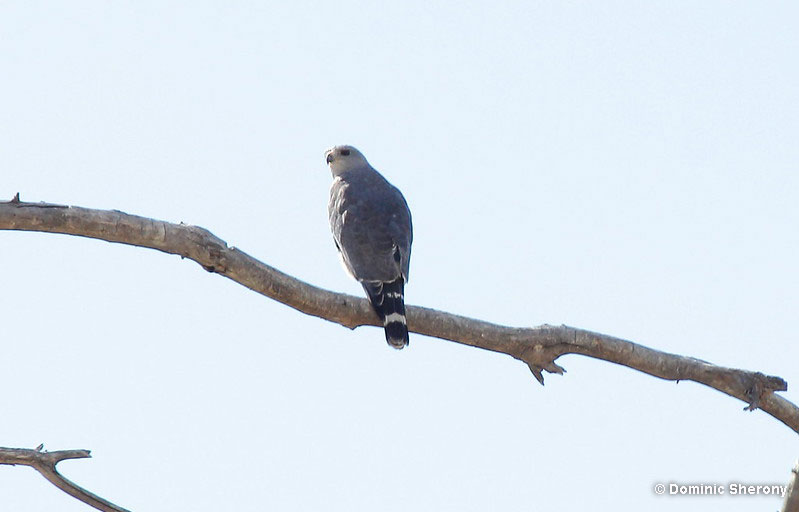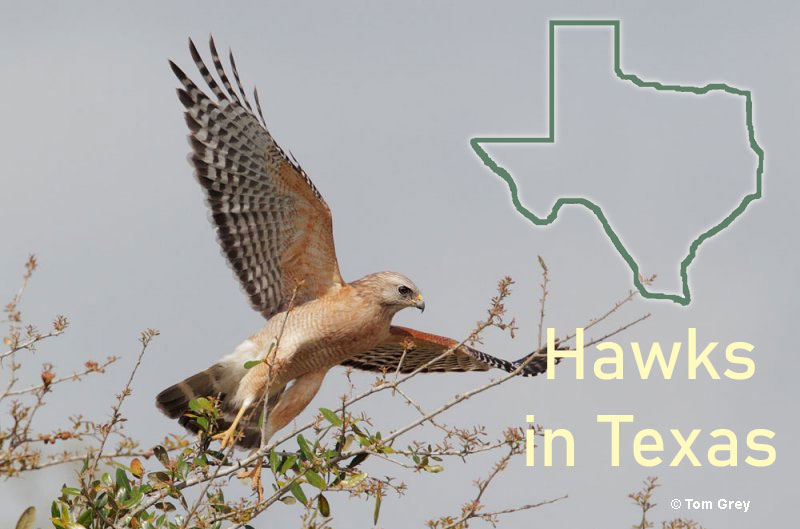
There are a lot of hawks in Texas! Take a drive anywhere in The Lone Star State and we see hawks perched on poles and soaring over fields.
How many hawk species live in this state’s woodlands, deserts, and plains? A lot! Learn all about the hawks of Texas in this article.
On this page
Most Common Hawks in Texas
According to recent eBird data from 2022-2023, 15 species of hawks in Texas were seen!
Most of the hawks of Texas are fairly common and easy to see. However, you still have to know where to look and how to recognize them.
Hawks can be challenging to identify! They can fly away fast, we don’t always see them in good lighting, and, despite their size, some species can hide surprisingly well.
These raptors are arranged from most common to least common.
Red-shouldered Hawk
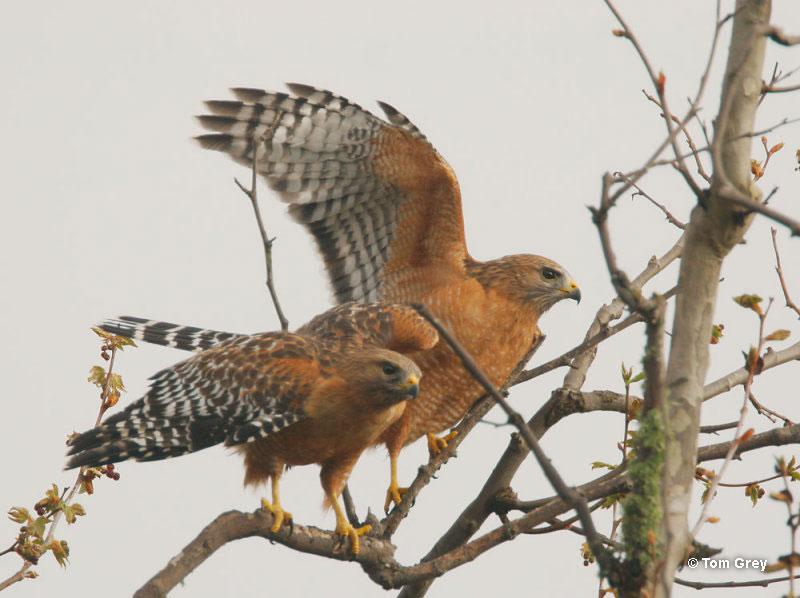
© Tom Grey
Scientific name: Buteo lineatus
Speed: 18-34 miles per hour
Length & Weight: 17 inches, 1.4 pounds
Wingspan: 40 inches
Call: “keer keer keer keer keer!”
The Red-shouldered Hawk is a medium-sized hawk with reddish-orange underparts and shoulder, and black and white on its wings and tail.
Both sexes are similar, but as with most raptors, females are larger than males. Young birds are brown above and have dark streaks on pale underparts.
In flight, all ages of this hawk species are best recognized by their longish, black and white tail and long wings with a pale crescent-shaped mark near the tip of the wing.
Red-shouldered Hawks prey on snakes, frogs, and other small animals. They forage by waiting on a perch and then swooping down to catch the animal on the ground.
This species builds a bulky stick nest high in a tree in wooded and semi-wooded areas, often near wetlands.
The Red-shouldered Hawk lives in a variety of woodland habitats in southeastern Canada, the eastern USA, California, southeastern Oregon, and Baja California, Mexico.
Key Identifications:
- Medium-sized, colorful hawk with reddish-orange underparts and shoulder, and black and white upperparts and tail.
- Forages for snakes and other small animals on the ground in woodland habitats.
- Builds a bulky stick nest high in a tree.
- Makes loud, jay-like, ringing calls, “keer keer keer keer keer!”
The Red-shouldered Hawk is a medium-sized hawk with reddish underparts and shoulder, and a black and white tail. This raptor lives in a variety of wooded areas and even wooded neighborhoods in California and Florida. This species can join American Crows to harass and chase away Great-horned Owls.
Red-tailed Hawk
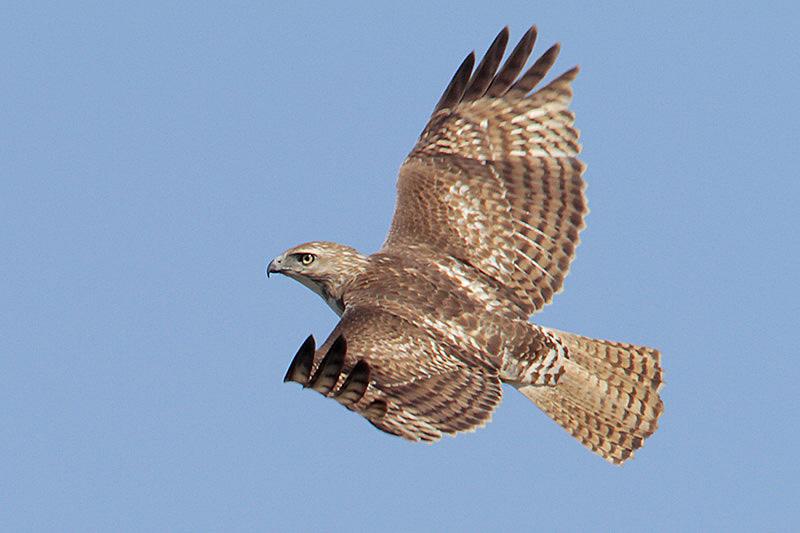
Red-Tailed Hawk (Juvenile) © Greg Lavaty.
Scientific name: Buteo jamaicensis
Speed: 20-40 miles per hour
Length & Weight: 19 inches, 2.4 pounds
Wingspan: 49 inches
Call: “keeeyah!”
The Red-tailed Hawk is a big and bulky hawk with dark brown upperparts and long, broad wings. Adults have a broad reddish tail and both sexes are similar (although females are larger than males).
In the east, adults have pale underparts with dark marks on their belly, but western birds can be dark brown, buff, or reddish-brown below. Young birds have brown tails with darks barring.
In flight, all Red-tailed Hawks show a large, somewhat square-shaped, pale area near the tips of their wings.
This species preys on a variety of small animals, including squirrels, rats, snakes, and birds. It catches prey by swooping down from a perch or from soaring flight.
Red-tailed Hawks build a messy stick nest high in a tree or on the ledge of a building.
They use a wide range of habitats in Alaska and the USA, much of Canada, Mexico, the Caribbean, and parts of Central America.
Key Identifications:
- Large, hefty hawk with a reddish tail and dark marks on its pale belly.
- Preys on small mammals, snakes, and birds.
- Builds a bulky stick nest high in a tree.
- Makes loud, jay-like, ringing calls, “keeeyah!”.
The Red-tailed Hawk is a hefty hawk with long broad wings, a broad reddish tail, and dark marks on its pale belly. In most places, this is the big hawk seen perched next to and soaring over roads and fields. The “raptor scream” often heard in movies and television shows is the call of the Red-tailed Hawk.
Northern Harrier
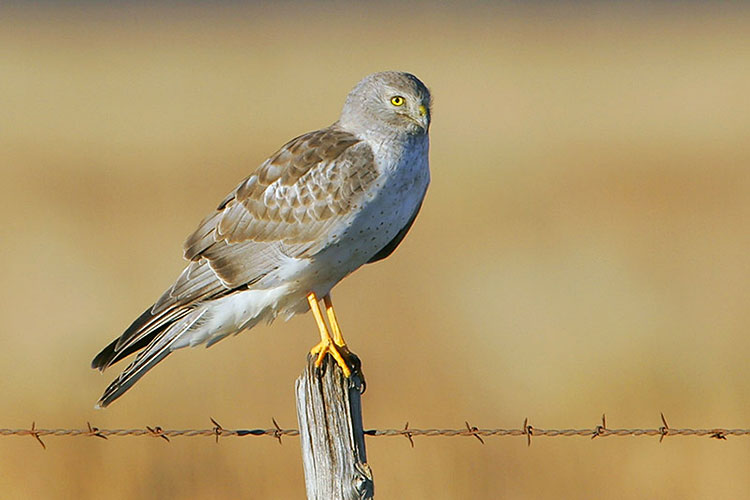
Scientific name: Circus hudsonius
Speed: 21-38 miles per hour
Length & Weight: 18 inches, 15 ounces
Wingspan: 43 inches
Call: “che che che che che che”
The Northern Harrier is a fair-sized, unique hawk with long wings, a long tail, and a white rump. Adult males have gray upperparts, head, and breast. They also have some pale brown spotting on their underparts and black tips on their wings.
Females are dark brown above and have dark brown streaks on pale underparts. Young birds are also dark brown above but have deep orange-buff underparts.
All Northern Harriers have a white rump and glide low over the ground on long wings held in a “V” shape.
This species prey on small animals caught on the ground, sometimes after hovering.
It uses grass and other vegetation to make a shallow, platform nest on the ground, in thick wetland or grassland areas.
Northern Harriers breed in grasslands and other open habitats in Alaska, Canada, California, and the northern and central USA. They winter in much of the USA, Mexico, and rarely to northern South America.
Key Identifications:
- Distinctive long-winged, long-tailed hawk with a white rump.
- Glides low over the ground to catch rodents and other small animals in marshes and other open grassy habitats.
- Builds.
- Makes a repetitive, woodpecker-like call, “che che che che che che”
Northern Harriers are long-tailed, long-winged hawks with white rumps. They glide low over the ground of grasslands and marshes to hunt for small animals. This bird and the Hen Harrier of northern Eurasia used to be considered the same species but despite their similar appearance, studies have shown that the Northern Harrier is a distinct species.
Cooper’s Hawk
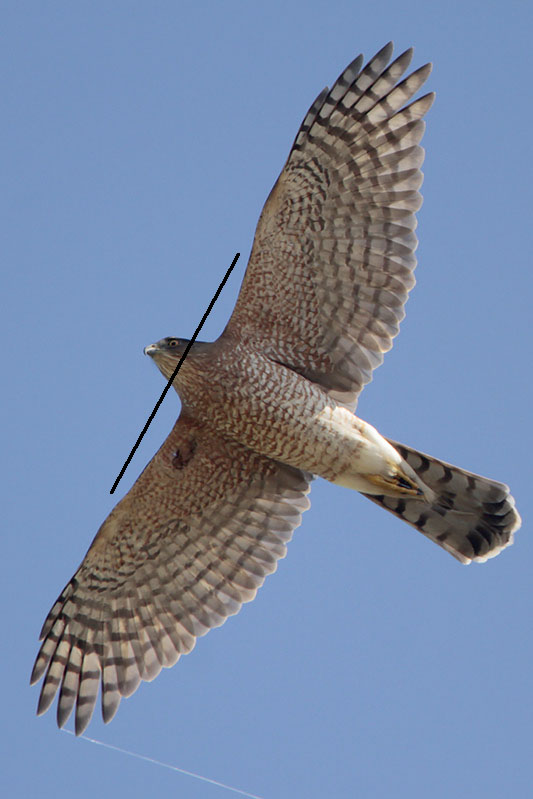
Scientific name: Accipiter cooperi
Speed: 21-55 miles per hour
Length & Weight: 16.5 inches, 1 pound
Wingspan: 31 inches
Call: “kek kek kek kek kek!”
The Cooper’s Hawk is a fair-sized hawk with a long, rounded tail and a blocky, square-shaped head. Adults are blue-gray above and have orange barring below.
Both sexes look similar although females are larger. They also often show a dark cap, have pale grayish on their face and side of the neck, and dark banding on their tail.
Young birds are shaped like adults but are dark brown above, have paler brown on the head, and fine dark streaking on pale underparts.
In flight, this species uses its rounded wings to make a few deep flaps followed by a brief glide.
The Cooper’s Hawk preys on doves and other medium-sized birds, and small mammals. It usually catches them on the ground and frequently attacks birds at feeders.
Cooper’s Hawks build a bulky stick nest high in a tree and often nest in parks.
This species lives in a variety of wooded and semi-wooded habitats in southern Canada, most of the USA, and in parts of Mexico.
Key Identifications:
- Fair-sized hawk with orange barring below, blue gray above, and a long rounded tail.
- Preys on small mammals and starlings and dove-sized birds in woodlands, parks, and towns.
- Builds a bulky stick nest high in a tree.
- Usually quiet but when breeding, it makes a loud barking call, “kek kek kek kek kek!”
In many areas, it has become adapted to people and catches birds and small mammals in woodlands and towns. The pesticide DDT caused large declines in Cooper’s Hawk populations in the 1950s and 60s but, since then, this species has regained its numbers and become a common bird.
Harris’s Hawk
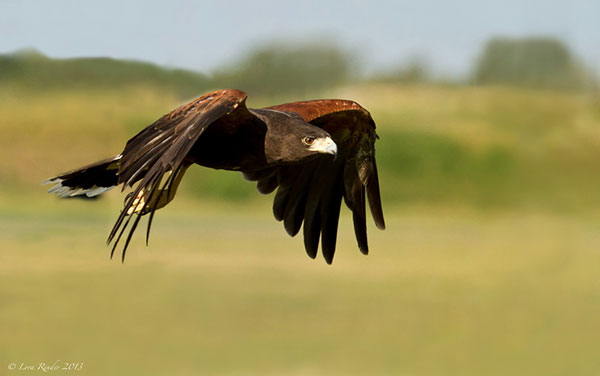
Scientific name: Parabuteo unicinctus
Speed: 22-28 miles per hour
Length & Weight: 20 inches, 1.5 pounds
Wingspan: 44 inches
Call: “kleeah, klee, klee, klee, klee”
The Harris’s Hawk is a large, dark brown and reddish-brown hawk with a long black and white tail, and much yellow on the base of its beak. Males and females look alike although females are larger.
This raptor species is dark brown with reddish-brown on its shoulders and thighs, has a white undertail, and a longish, black and white tail.
Young birds are like adults but have a paler tail, paler flight feathers, and dark streaks on their underparts.
This hawk soars and makes slow, deep flaps on fairly long, broad wings.
This species feeds on a variety of medium-sized mammals, reptiles, and birds. It catches them by swooping down from a perch or from low flight.
The Harris’s Hawk builds a bulky stick nest in a large cactus or a tree.
Harris’s Hawks live in desert and subtropical habitats from Texas and parts of the southwestern USA south to Argentina.
Key Identifications:
- Large, dark brown and reddish-brown hawk with a long black and white tail.
- Preys on rabbits and other small animals and birds.
- Builds a bulky stick nest in a large cactus or other sturdy structure.
- Makes ringing, rather high-pitched calls, “kleeah, klee, klee, klee, klee”.
The Harris’s Hawk is a big, dark brown and reddish-brown hawk with a long black and white tail. They live in arid and subtropical habitats and often occur in small groups. In Arizona and other desert habitats, several members of this species cooperate and hunt together to catch rabbits and other animals.
Swainson’s Hawk
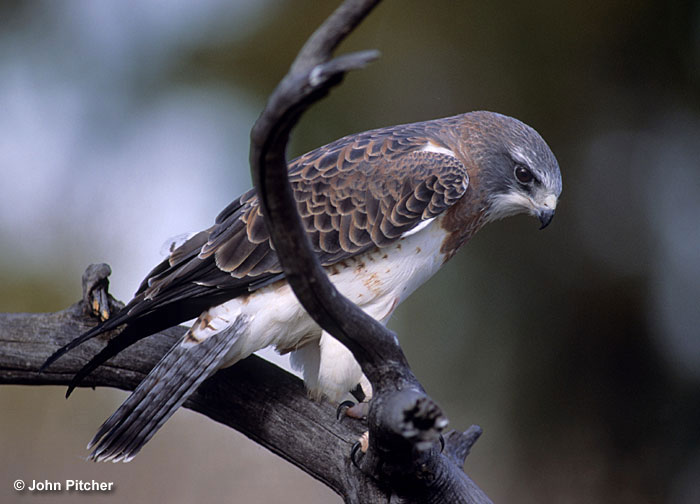
Scientific name: Buteo swainsoni
Speed: 15-60 miles per hour
Length & Weight: 19 inches, 1.9 pounds
Wingspan: 51 inches
Call: “eeeah!”
The Swainson’s Hawk is a big hawk with dark-brown upperparts, long, pointed wings with dark flight feathers, and a broad tail with fine dark barring and a dark tip. Males and females are similar although females are larger.
Adults can have a white throat, front, wing linings, and underparts with a red-brown breast. They can also have a white throat and front, and reddish brown underparts and wing linings, or be entirely dark brown.
Young birds can have dark markings on pale underparts or be mostly dark below.
This species catches grasshoppers and small animals on the ground. It forages by soaring and then swooping down or walking on the ground.
It builds a bulky stick nest in a tree.
Swainson’s Hawks breed in grasslands, meadows, and other open habitats in central and western Canada and the USA. They migrate through the central USA and winter in grasslands in Argentina. A few also migrate through and winter in southern Florida.
Key Identifications:
- Large, long-winged hawk with dark flight feathers and a broad tail with fine dark banding and a dark tip.
- Feeds on insects and small animals in prairies and other open habitats.
- Builds a bulky stick nest in a tree.
- Makes a loud, descending, single note, “eeeah!”.
The Swainson’s Hawk is a large, long-winged raptor with dark flight feathers and some white on the rump. It soars above and perches in trees, and on the ground in prairies and other open habitats. This species migrates from western North America all the way to grasslands in Argentina.
Sharp-shinned Hawk
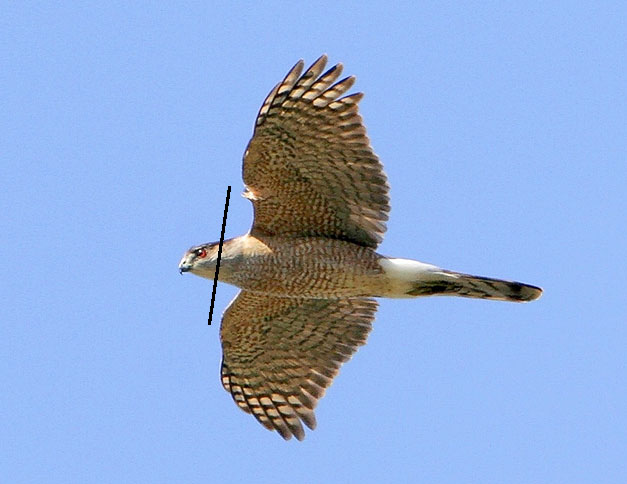
Scientific name: Accipiter striatus
Speed: 16-60 miles per hour
Length & Weight: 11 inches, 5 ounces
Wingspan: 23 inches
Call: “kew kew kew kew kew kew kew kew”
The Sharp-shinned Hawk is a small hawk with a long, rectangular tail and rounded wings. Adults have blue-gray upperparts, orange barring on their underparts, and dark bands on their tail.
Females are larger than males and young birds are dark brown above with thick brown streaks on pale underparts.
This species flies with several quick wing beats followed by brief glides. When flying, its head doesn’t stick out as much as a Cooper’s Hawk and it shows a square-tipped tail.
The Sharp-shinned Hawk preys on small birds up to the size of an American Robin. It mostly catches birds around the same size as sparrows, warblers, and vireos by quickly flying and catching them in vegetation.
This hawk builds a bulky stick nest high in a conifer.
Sharp-shinned Hawks live in wooded habitats in Alaska, much of Canada and the USA, Mexico, parts of Central America, the Caribbean, and parts of South America.
Key Identifications:
- Small hawk with rounded wings and a long, rectangular tail.
- Preys on small birds in woodland habitats.
- Builds bulky stick nest high in a conifer.
- Usually quiet but on breeding grounds makes falcon-like, repeated ringing calls “kew kew kew kew kew kew kew kew”.
This small hawk with a long, rectangular tail breeds in coniferous forests and winters in a range of wooded habitats. It often attacks small birds at feeders. The Sharp-shinned Hawk gets its name from its thin legs that have angled, “sharp” shins.
White-tailed Hawk
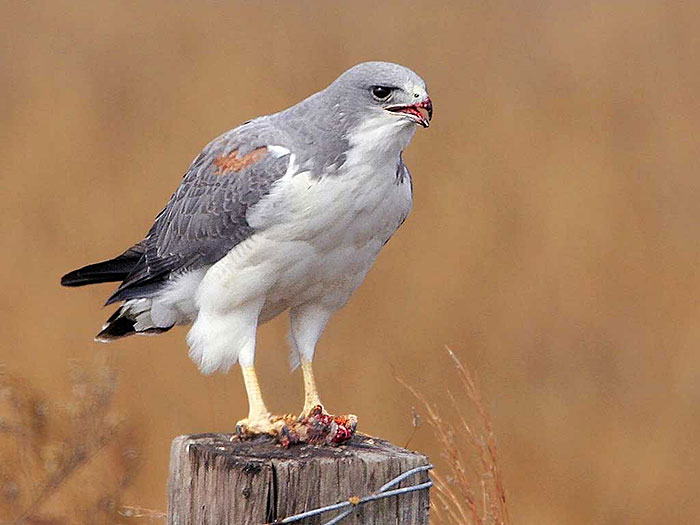
Scientific name: Accipiter atricapillus
Speed: around 22 to 28 miles per hour
Length & Weight: 20 inches, 2 pounds
Wingspan: 50 inches
Call: “kereaaah kurih kurih kurih kurih!”
The White-tailed Hawk is a large, long-winged hawk that has a short, white tail with a dark tip. Both sexes look the same but females are larger than males. Adults of this species are white below and dark gray above with rufous shoulders, a hooded appearance, and a white lower back.
Juveniles are mostly dark gray or blackish, have a pale tail, and a white patch on the upper breast.
This raptor flies with long, pointed wings that have darkish flight feathers. They soar high overhead, hover, and hold themselves in place while flying into the wind.
The White-tailed Hawk preys on small animals and large insects that it catches on the ground.
White-tailed Hawks build loose, flat stick nests in a low tree in grassy areas.
This species mostly lives in tropical savannah and grasslands from Mexico to Argentina but it also ranges into southern Texas north to around Houston.
Key Identifications:
- Large, long-winged hawk with a pale tail.
- Preys on small animals in tropical grasslands and savanna habitats.
- Builds a loose, large flat nest of sticks and other materials in a low tree.
- Makes a long introductory note followed by repeated calls, “kereaaah kurih kurih kurih kurih!”.
The White-tailed Hawk is a large raptor with long, pointed wings and a pale tail. They hunt small mammals and birds in open, scrubby habitats in southern Texas. The nests of this species usually have one longer stick that extends from the nest.
Broad-winged Hawk
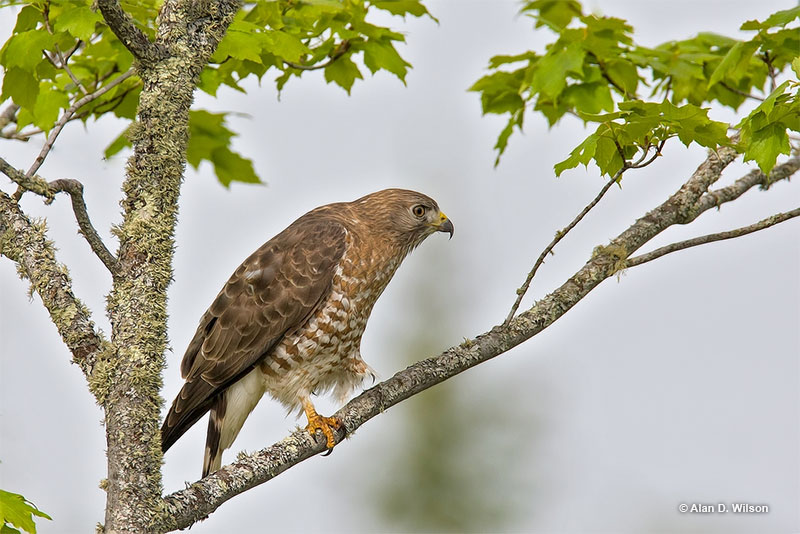
Scientific name: Buteo platypterus
Speed: 20-40 miles per hour
Length & Weight: 15 inches, 14 ounces
Wingspan: 34 inches
Call: “sipeeeeeeeee”
The Broad-winged Hawk is a smallish raptor around the same size as a crow. Adults are dark brown above, have dark, reddish-brown barring below, and a broad tail with a few wide, white bands.
Both sexes look the same and also have a thick dark mark on each side of their throat although females are larger. Young birds have dark brown streaks on pale underparts.
In flight, this species often soars, shows a broad black and white tail, and has long wings shaped like a “paring knife” that also have a dark trailing edge.
This raptor preys on voles, frogs, insects, and other small animals. It catches food by waiting on a perch and then quickly swooping down to the ground.
Broad-winged Hawks make a bulky stick nest high in a tree.
This small hawk breeds in forest habitats in central and southeastern Canada and much of the eastern USA. It winters in southern Florida and Mexico south to Bolivia.
Key Identifications:
- Chunky, smallish, crow-sized hawk with a few white bands on its tail and underparts with brown barring or streaks.
- Preys on insects and small animals in woodland habitats.
- Builds a bulky nest high in a tree.
- Makes a high-pitched call, “sipeeeeeeeee”
This chunky, crow-sized hawk has a few prominent white bands on its broad tail and either dark barring below or dark streaks. It often soars above and near woodland habitats. In southern Texas and some other places, thousands of Broad-winged Hawks can be seen as they migrate between breeding and tropical wintering grounds.
Gray Hawk
Scientific name: Buteo plagiatus
Speed: around 22 to 28 miles per hour
Length & Weight: 20 inches, 1.05 pounds
Wingspan: 35 inches
Call: “Keeeear!”
The Gray Hawk is a smallish raptor around the same size as a crow. Adults look the same and are gray with gray barring below and have a longish black and white tail.
Juveniles are dark brown above and have a black and yellow beak. They also have a white face with a dark mark through each eye, dark mark on each side of the throat, narrow white rump, and dark brown streaks and markings on white underparts.
In flight, Gray Hawks use medium-length wings to soar and make a few deep flaps between glides.
This species feeds on lizards, small birds, and other small animals. It catches prey on the ground and from vegetation after a quick, brief chase.
Gray Hawks build a bulky stick nest high in a trees.
This raptor is a tropical species that lives in southeastern Arizona and parts of southern Texas south to Costa Rica.
Key Identifications:
- Crow-sized, gray-plumaged hawk with a black and white tail and gray barring below.
- Preys on reptiles and other small animals in arid and subtropical habitats.
- Builds a messy, stick nest high in a tree.
- Quite vocal. Gray Hawks make a clear, descending call, “Keeeear!”. It also makes loud, repeated whistles,“keree, keree, keree, keree”.
Gray Hawks are crow-sized, gray or brown, streaked raptors of riparian zones and other subtropical habitats. They prey on reptiles, birds, and other small animals. In reference to its shape and range, this species used to be known as the “Mexican Goshawk”.
Zone-tailed Hawk
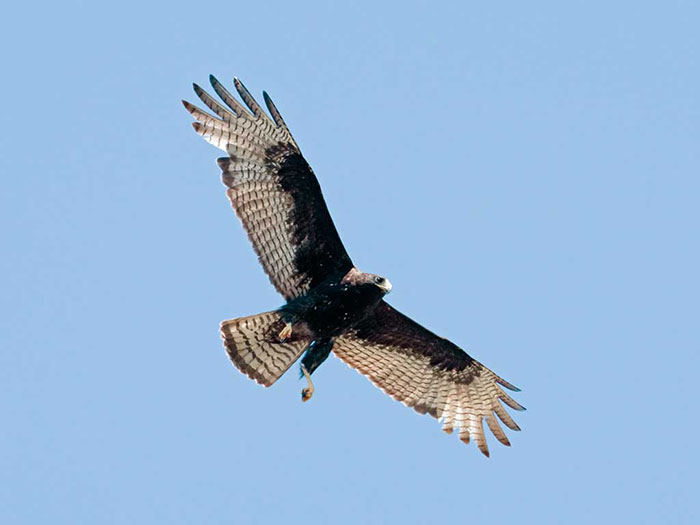
Scientific name: Buteo albonotatus
Speed: around 22 to 28 miles per hour
Length & Weight: 20 inches, 2 pounds
Wingspan: 50 inches
Call: “reeeeyah!”
The Zone-tailed Hawk is a medium to large, slender, black hawk with long wings and a longish, black and white tail. Both sexes are similar but females are larger. Their wings also have grayish, barred flight feathers and a dark trailing edge, and they have a black and yellow beak.
Young birds look like adults but have grayer flight feathers and fine black banding in their tail.
This raptor species soars on long wings held in a “V” shape and often flies with the similar Turkey Vulture.
Zone-tailed Hawks prey on small mammals, birds, and small reptiles. They forage by mimicking a Turkey Vulture so they can sneak up on and catch animals in vegetation and on the ground.
This species builds a stick nest high in a tree or on a cliff.
The Zone-tailed Hawk lives in shrubby and forested habitats in the American southwest south to Bolivia.
Key Identifications:
- Black, slender raptor that flies like a Turkey Vulture and has long wings and a longish, black and white tail.
- Catches birds and other small animals on the ground and in the tops of bushes and trees.
- Builds a stick nest on a cliff or in a tall tree.
- Makes a long, drawn out, somewhat hoarse, “reeeeyah!”.
The Zone-tailed Hawk is a black hawk that flies like a Turkey Vulture and has long wings and a longish black and white tail. They live in shrubby arid habitats and tropical forests from the American southwest south to Bolivia. This species often catches small animals trying to escape from fires in grassy and shrubby habitats.
Ferruginous Hawk
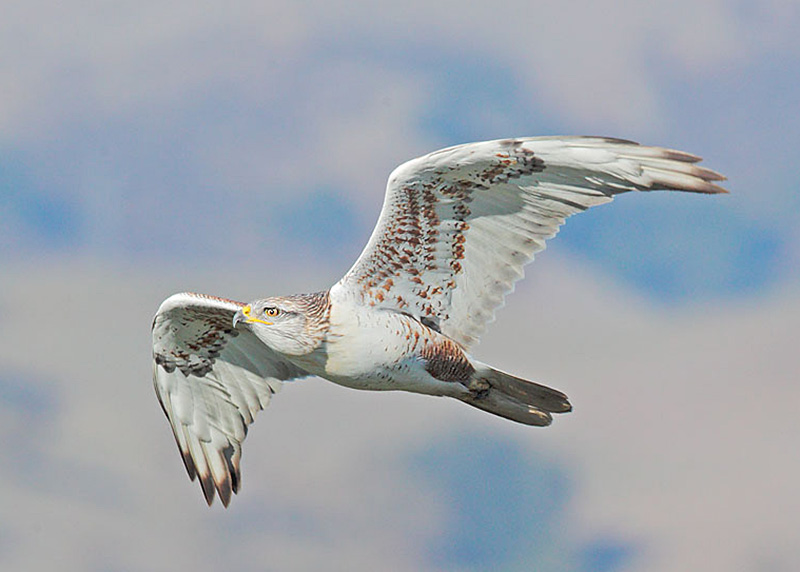
Photograph © Tom Grey.
Scientific name: Buteo regalis
Speed: up to 150 miles per hour
Length & Weight: 23 inches, 2.3 pounds
Wingspan: 55 inches
Call: “reeaaaauh!”
The Ferruginous Hawk is a big hawk with a pale tail, long wings, and feathered legs. There are two color morphs.
Adults can be white below with red-brown on their wing linings and flanks. They also have reddish-brown legs and are reddish-brown and pale gray above. Dark morphs are dark brown with a pale tail and pale flight feathers.
Juveniles are paler below and lack reddish-brown colors.
In flight, it soars with wings held in a shallow “V”. Pale primary patches are also visible on the upper sides of each wing.
The Ferruginous Hawk preys on prairie dogs and other mammals but can also catch waterfowl. It waits on the ground, low perch, or flying low and then snatching prey with its talons.
It builds a big, bulky stick nest in a lone tree, or on a rock outcropping or other structure.
This raptor lives in wide open habitats in south-central Canada, the western USA and northern Mexico.
Key Identifications:
- Big pale or dark hawk with long wings and a pale tail.
- Preys on prairie dogs, other mammals, and waterfowl in wide open habitats.
- Builds a big and bulky stick nest in an isolated tree or other structure.
- Makes a hoarse, descending call, “reeaaaauh!”.
The Ferruginous Hawk is a big, eagle-like, pale raptor with reddish-brown and gray upperparts. It can also be dark brown with a pale tail and pale flight feathers, and lives in prairies and other wide open habitats. “Ferruginous” means “rust-colored” and refers to the reddish plumage on their backs and legs.
Common Black Hawk
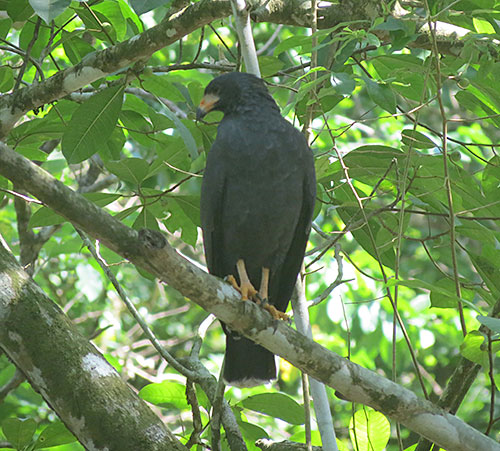
Common Black Hawk
Scientific name: Buteogallus anthracinus
Speed: around 22 to 28 miles per hour
Length & Weight: 19 inches, 2.1 pounds
Wingspan: 50 inches
Call: “klick kee kee keep kickakip”
The Common Black Hawk is a bulky black hawk that has a short, broad tail with one wide white band and a narrow white tip. Males and females look similar but females are larger.
Young birds are dark brown above and have dark brown streaks on buff underparts. They also have a buff face with a dark line through each eye, a dark brown mark on each side of their throat, and a pale tail with fine black barring.
This bird soars on broad wings with a dark outline and a pale “crescent” on the base of the primaries. Young birds have a large pale patch near their wing tips.
This raptor catches fish, insects, and other small animals on the ground, in and near streams and other wetlands.
It builds a messy stick nest in a tree near a stream.
The Common Black Hawk lives in gallery forest in parts of Arizona and near lowland wetland habitats in Mexico, Central America, and northern South America.
Key Identifications:
- Big, bulky black hawk with a short, broad, black and white tail.
- Preys on fish, crustaceans, insects, and many other small animals.
- Builds a bulky stick nest in a tree.
- Makes repeated, high-pitched whistled calls, “klick kee kee keep kickakip”.
The Common Black-Hawk is a big, bulky hawk with a short, broad, black and white tail and black plumage, or buff plumage with dark brown markings. It frequents gallery woodlands along streams and tropical woodlands next to other wetland habitats. When hunting in water, they can wade in the water and use their wings to drive prey to a spot where the small animals are easier to catch.
Rough-legged Hawk
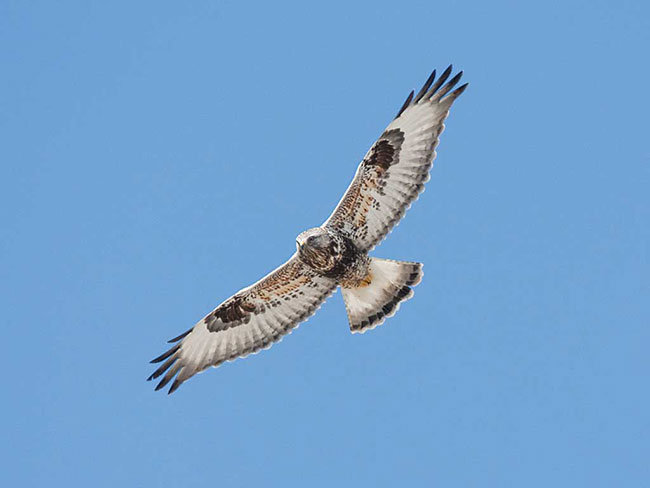
Scientific name: Buteo lagopus
Speed: 22-28 miles per hour
Length & Weight: 22 inches, 1.3 to 3.6 pounds
Wingspan: 53 inches
Call: “reeaaaauh!”
The Rough-legged Hawk is a long-winged hawk with a black and white tail. There are two color morphs; both with broad white patches near dark wing tips, and a longish pale tail with a broad black tip.
Pale females and juveniles are pale gray-brown with a black belly and black “wrists” in their wings. Pale adult males are more cold gray, have less black on their belly, and heavily streaked breasts.
Dark females and juveniles are dark brown except for their tail and flight feathers. Dark adult males are black except for their flight feathers and tail.
In flight, this species holds its wings in a shallow “V”.
Rough-legged Hawks soar and hover over open fields where they prey on voles and other small animals.
It builds a bulky nest on a cliff or rocky outcropping.
The Rough-legged Hawk breeds in tundra in Alaska, northern Canada, and northern Eurasia, and winters in open fields in southern Canada, the northern, central, and western USA, and Europe and Asia.
Key Identifications:
- Big hawk with a longish black and white tail, and long wings with broad white patches near the dark wing tips.
- Preys on rodents and other small animals in wide open habitats.
- Builds a big, bulky nest on cliffs and rocky outcroppings in tundra.
- Makes a loud, clear descending call, “reeaaaauh!”.
The Rough-legged Hawk is a big, long-winged hawk with a black and white tail, and broad white patches near the tips of their wings. They hover and soar over weedy fields and other open habitats to hunt for rodents and birds. This species is one of the only hawks in North America that has feathers on its legs.
Short-tailed Hawk
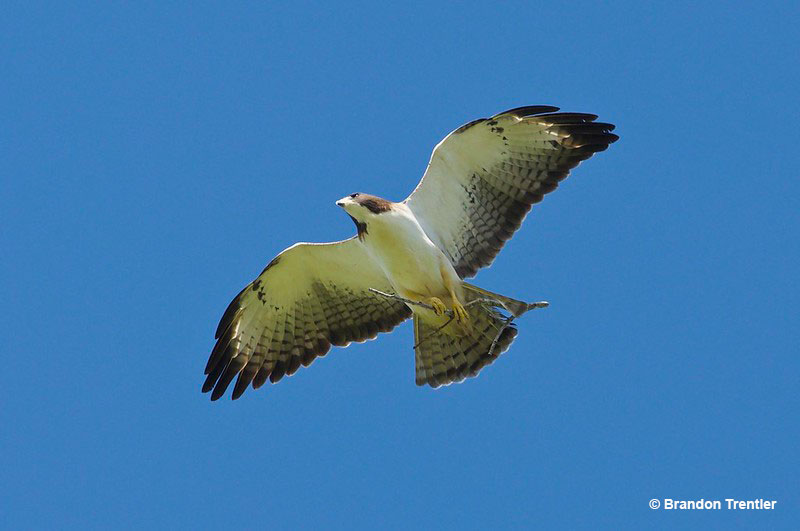
Scientific name: Buteo brachyurus
Speed: 20-40 miles per hour
Length & Weight: 16 inches, 15 ounces
Wingspan: 37 inches
Call: “reeeeeee!”
The Short-tailed Hawk is a small soaring raptor with two color morphs. It can have a hooded appearance and be dark above and pale below, or be mostly black. Both sexes look similar although females are larger than males.
In flight, it has a squared tail with some fine dark bands, and long wings with dark barring on the flight feathers and a thick dark trailing edge.
Young birds resemble adults but have a few marks on their breast or pale spotting below.
This species feeds on small birds, reptiles, and large insects. It catches prey by flying high in the air and then quickly dropping down to snatch the animal in vegetation or on the ground.
Short-tailed Hawks build a bulky stick nest high in a tree.
This tropical species uses forest and semi-open habitats from Mexico to Brazil. However, in North America, it is resident in Florida and a rare vagrant to southern Texas.
Key Identifications:
- Small soaring hawk that is dark above and pale below or mostly black.
- Preys on small birds, lizards, and other small animals in various subtropical habitats of Florida.
- Builds a bulky stick next high in a tree.
- Makes a drawn out clear call, “reeeeeee!”, usually while soaring high overhead.
The Short-tailed Hawk is a small soaring raptor with two color morphs; birds that are pale below and dark above or mostly black. They swoop down on small birds and other small animals in treetops in a variety of tropical habitats in Florida. In the USA, this species is restricted to Florida where 500 or so birds occur and migrate to the southern part of the state for the winter.
Frequently Asked Questions
How big are hawks in Texas?
Hawks in Texas range in size from the big Ferruginous Hawk (23 inches long and four and half foot wingspan) to the small Sharp-shinned Hawk (11 inches long and 23 inch wingspan).
What are the little hawks in Texas?
The little hawks in Texas are Sharp-shinned Hawks. This species is only a bit bigger than an American Robin, is 11 inches long, and has a wingspan of 23 inches.
Are there hawks in North Texas?
Yes, there are many hawks in North Texas. The more commonly seen species of hawks in North Texas are the Red-tailed Hawk, the Swainson’s Hawk, and the Cooper’s Hawk.
What state has the most hawks?
Texas is the state that has the most hawks. 19 species of hawks are on the official Texas bird list.
What do hawks in Texas eat?
Hawks in Texas eat small mammals, birds (even ducks), frogs, snakes, and insects.
Are all hawks protected in Texas?
Yes, all hawks in Texas are protected by Texas state laws and the Federal Migratory Bird Treaty Act.
Many hawks are native to Texas. Four of the most common native hawks in Texas are Red-shouldered Hawk, Red-tailed Hawk, Northern Harrier, and Cooper’s Hawk.
Discover more about Texas: Most common birds | Hummingbirds | Owls | Ducks


